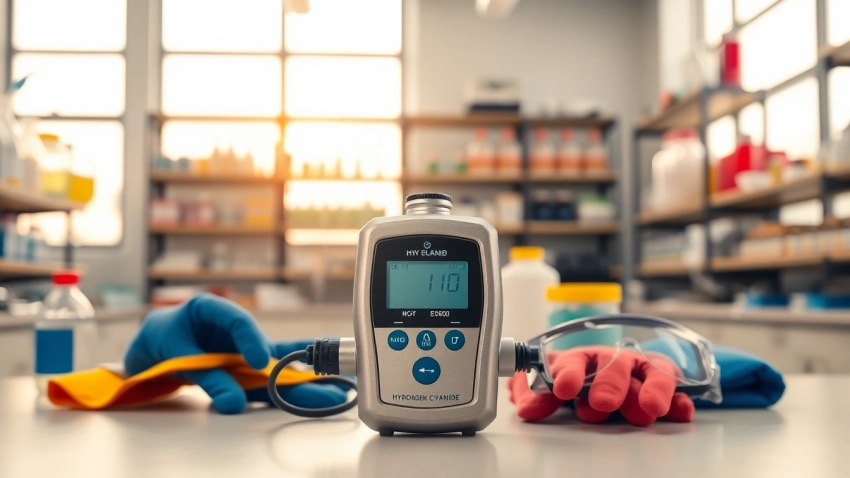
Reliable Solutions with Hydrogen Cyanide Gas Detectors for Workplace Safety
Understanding Hydrogen Cyanide: Properties and Risks
What is Hydrogen Cyanide and Where is it Found?
Hydrogen cyanide (HCN) is a highly toxic, colorless gas with a faint, bitter almond smell. It is known for its extreme toxicity and can be lethal in low concentrations. Commonly used in industrial processes, HCN is primarily produced in the manufacture of plastics, synthetic fibers, and certain types of pesticides. Additionally, it can occur as a by-product in various chemical reactions, such as those associated with combustion processes, and in structures that are subjected to fire where materials containing nitrogen are combusted. It is crucial for industries handling materials that may emit hydrogen cyanide to invest in appropriate detection equipment, such as a Hydrogen Cyanide gas detector, to mitigate exposure risks.
Health Hazards Associated with Hydrogen Cyanide Exposure
Hydrogen cyanide is highly toxic to humans and can be absorbed through inhalation, skin contact, or ingestion. Symptoms of exposure can manifest quickly, including headaches, dizziness, confusion, and in severe cases, loss of consciousness or death. The gas disrupts the body’s ability to use oxygen by inhibiting cellular respiration, making its rapid detection essential, particularly in workplaces where it may be present. The threshold limit value for HCN exposure is set at 10 parts per million (ppm) by the American Conference of Governmental Industrial Hygienists (ACGIH), and continuous exposure to such levels can lead to serious health complications or fatalities.
Environmental Impact of Hydrogen Cyanide
Beyond its health risks, hydrogen cyanide can have detrimental effects on the environment. Once released into the atmosphere, it can contribute to air pollution and can also be harmful when it enters waterways. Its potent toxicity affects aquatic life, often causing fish kills and disrupting local ecosystems. Reducing hydrogen cyanide emissions is a significant focus for many industries, necessitating the incorporation of reliable detection systems to monitor and manage potential leaks and emissions responsibly.
The Importance of Hydrogen Cyanide Gas Detectors
How Gas Detectors Work: Mechanisms Explained
Hydrogen cyanide gas detectors function through various mechanisms, primarily relying on sensors that respond to the presence of HCN in the air. These sensors may utilize electrochemical technology, infrared sensors, or photoionization detectors to continuously monitor air quality and detect the presence of hydrogen cyanide. When the gas is detected, the systems trigger alarms and notifications, enabling rapid response and mitigation strategies to ensure worker safety. Some sophisticated detectors also log data, making it easier for companies to analyze and address potential safety hazards over time.
Key Benefits of Using Hydrogen Cyanide Gas Detectors
The incorporation of hydrogen cyanide gas detectors in industrial settings offers numerous benefits, including:
- Enhanced Safety: These detectors alert personnel swiftly in case of HCN presence, thereby preventing acute health issues.
- Regulatory Compliance: Many industries are required to adhere to stringent regulations concerning hazardous substances; detectors assist in fulfilling these obligations.
- Data Collection: Advanced detectors provide valuable data for monitoring air quality trends and enhancing workplace safety protocols.
- Cost Savings: Preventing exposure-related incidents minimizes potential medical costs, legal liabilities, and downtime due to emergencies.
Industry Standards and Compliance Requirements
Compliance with safety regulations is fundamental to any business dealing with hazardous chemicals. Organizations such as the Occupational Safety and Health Administration (OSHA) and the Environmental Protection Agency (EPA) mandate specific standards for hydrogen cyanide handling and detection. Companies must not only ensure that their facilities are equipped with hydrogen cyanide gas detectors but must also foster a culture of safety, reinforcing training and compliance with established best practices to reduce the risk of exposure.
Types of Hydrogen Cyanide Gas Detectors
Portable vs Fixed Gas Detectors: What You Need to Know
Hydrogen cyanide gas detectors can be classified into two primary types: portable and fixed. Portable detectors are compact and battery-operated, allowing users to carry them around and monitor HCN levels in various locations, making them ideal for fieldwork or short-term exposure scenarios. On the other hand, fixed detectors are stationary units installed at critical points within plants or facilities; they provide continuous monitoring and are often connected to integrated alarm systems. Deciding which type to use depends on the specific operational needs and the levels of risk associated with hydrogen cyanide exposure in a particular environment.
Top Features to Look for in a Hydrogen Cyanide Detector
When selecting a hydrogen cyanide gas detector, it is important to consider features that enhance performance and usability:
- Response Time: Quick detection is critical, so look for detectors with rapid response capabilities to mitigate risks promptly.
- Calibration and Sensitivity: The ability to calibrate the detector helps maintain accuracy and effectiveness, especially in varying environmental conditions.
- Data Logging: Models that offer data logging capabilities allow for better tracking and response planning over time.
- Alarm System: Audible and visual alarms provide immediate alerts to ensure a swift reaction during a detection event.
Comparing Popular Models on the Market
There are various hydrogen cyanide detectors available that cater to different needs and preferences. Some popular models include:
- Model A: A portable detector known for its lightweight design and quick response time, suitable for field applications.
- Model B: A fixed detector designed for continuous monitoring in industrial settings, equipped with advanced data logging features.
- Model C: Recognized for its dual-sensor technology that enhances sensitivity and accuracy in detecting low levels of hydrogen cyanide.
When choosing a model, consider aspects such as user reviews, support services, and warranty offerings to ensure the best fit for your specific requirements.
Best Practices for Using Hydrogen Cyanide Gas Detectors
Installation Guidelines for Optimal Performance
To maximize the effectiveness of hydrogen cyanide gas detectors, proper installation is crucial. Fixed detectors should be positioned strategically in areas where hydrogen cyanide is most likely to accumulate or where employees are at higher risk of exposure. It is also essential to follow the manufacturer’s guidelines regarding height, distance from walls, and environmental conditions to ensure accurate monitoring. For portable detectors, users should be trained on optimal usage situations to facilitate timely and effective monitoring.
Regular Maintenance: Ensuring Your Detector Works
Routine maintenance of hydrogen cyanide gas detectors is vital to ensure ongoing functionality and reliability. This includes regular calibration checks, testing alarms, and replacing any components as recommended by the manufacturer. Developing a maintenance schedule will help monitor detector performance and prevent lapses in safety coverage.
Training Employees on Proper Usage
Education and training play a pivotal role in the effective use of hydrogen cyanide gas detectors. Conduct thorough training sessions for employees on how to operate the devices, interpret readings, and respond appropriately in case of an alarm. Simulation drills and refresher courses can reinforce this knowledge and foster a culture of safety in the workplace.
Future Trends in Hydrogen Cyanide Detection Technology
Advancements in Sensor Technology
The landscape of gas detection technology is continuously evolving, with advancements aimed at improving sensitivity, accuracy, and response times. New sensors are being developed to operate at lower concentrations of hydrogen cyanide, providing earlier warnings and improving safety standards across industries. Additionally, integration with AI and machine learning is expected to enhance predictive capabilities and allow for sophisticated data analytics.
The Role of IoT in Gas Detection
The Internet of Things (IoT) is set to revolutionize the capabilities of hydrogen cyanide gas detectors. By connecting detectors to a network, companies can facilitate real-time data sharing, automatic reporting, and maintenance notifications that enable proactive management of safety systems. Enhanced connectivity will foster a holistic approach to environmental monitoring, significantly improving workplace safety.
Predictions for the Next Decade in Gas Detection Solutions
Looking ahead, the gas detection industry is likely to see increased integration of smart technology, with a focus on automation and remote monitoring systems that offer greater control over safety parameters. The emergence of wearable gas detection devices may also become prevalent, providing personal monitoring for workers in hazardous environments. As regulations continue to tighten and technology matures, the future of hydrogen cyanide detection promises significant advancements that prioritize safety and efficiency in the workplace.












Leave a Reply